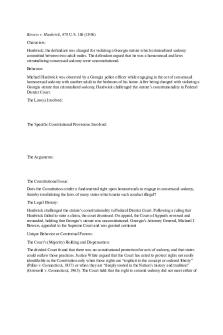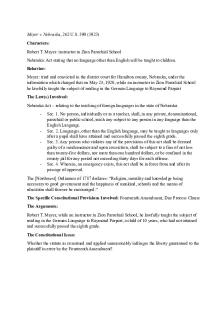Bakke Case Brief Notes PDF

| Title | Bakke Case Brief Notes |
|---|---|
| Author | Kevin Vincent |
| Course | Civil Rights in America |
| Institution | California Polytechnic State University San Luis Obispo |
| Pages | 5 |
| File Size | 59.4 KB |
| File Type | |
| Total Downloads | 57 |
| Total Views | 170 |
Summary
Professor Ron Den Otter...
Description
Key Terms: ● Diversity ○ Racial diversity as a compelling state interest is not good enough ○ Diversity in its broadest terms (not just race) is considered a compelling state interest ○ The legislative classification is narrowly tailored if they use race as a plus factor ● Pool problem ○ If we based admission purely on numbers, only 30 african americans would get in a law school ○ If you just based admission purely on numbers (LSAT score and undergraduate GPA), you will not have very much racial diversity in elite law schools ■ Huge racial achievement gap in the US ■ Racial educational gap ● Daily reports ○ Keeping track of racial composition of the class through rolling admissions ● Critical mass ○ Not a specific number; if you admit enough members of minority groups, in the class, it will have a more diverse group and the minority groups would feel comfortable around their own minority group → for campus life ○ Sufficient number of minority students so that they’re not alone ● Holistic individualized Review ○ You're not being assigned a specific amount of points for your race, but your race is a plus factor Bakke (1978) ● Which standard of review (sor) should be applied to race-conscious affirmative action plans? ○ Benign vs individous discrimination ■ Benign- designed to help underrepresented racial minority groups who have been or continue to be discriminated against ; not designed to harm white people; benign motives (race-conscious affirmative action plan) ● Trigger intermediate scrutiny ○ Therefore does not violate EPC ■ ● How did Powell apply strict scrutiny (ss)? ● Brennan group vs Rehnquist group ● Race as a plus factor ○ Title VI ○ EPC ● Did Justice O’Conner really apply strict scrutiny? ● Compelling state interest? ● Narrowly tailored?
Bakke ● The first race conscious affirmative action case ● UC Davis medical school ○ First medical class was mostly white, little Asian ● 1973- disadvantaged students had 2.8 ○ MCAT score average of 35th percentile vs 85th percentile (white people) ● Bakke was denied in 1973, 1974 ○ Denied to the other 11 medical schools ○ Too old ● Final opinion ○ 134 pages ● Bakke ultimately admitted to the medical school ● UC ○ 100 seats for the first year medical class ○ 16- set aside for underrepresented minority groups ■ Only competing against non-white applicants for those 16 seats ■ Affirmative action applied for Asian students ● Bakke sued UC Davis on 2 grounds (reverse discrimination) ○ Title XI case ■ Under federal law, UC Davis has racially discriminated against because they indirectly disadvantage me because if my race ■ No federal funds will go to public schools that practice racial discrimination ○ Does UC davis race conscious affirmative action plan violate the EPC? Remedy ● Bakke is admitted to UC Davis medical school The justices who dissent in Bakke ● Brennan group The justices in the majority ● Rehnquist group Rehnquist group ● It violates Title VI; violates federal group (4) ● Powell believes the UC davis race conscious affirmative action plan violate the EPC ○ Plurality opinion ● Apply strict scrutiny ● Racial classification is a racial classification ○ Avoid all racial classifications
Brennan group ● Does not violate violates Title VI; violates federal group ● Does not the UC davis race conscious affirmative action plan violated the EPC ● Intermediate strict scrutiny ○ race conscious affirmative action plan has better chance surviving ○ Benign discrimination ● Not a traditional racial classification ○ No sense of racial inferiority ● Strict scrutiny ○ Meant to protect minority groups ■ Not white people Powell ● Strict scrutiny should be used because it a racial classification ● Compelling state interest ○ Remedy past racial discriminations ■ Not compelling ○ Integrating minority into the medical field ○ Induce doctors to serve in disadvantaged areas ■ Inefficiently compelling ○ Diversity ■ Due to educational benefits, Sufficiently compelling state ■ In the broadest or widest sense ■ Not limited to race diversity ■ Socioeconomic, age, political, geographical, religion, diversity ■ So important that it’s compelling ● Narrowly tailored ○ Only incorporating race diversity ○ Not the quota per say ○ The problem is that quota is only about the race diversity ■ The nature of the quota ● Fails strict scrutiny ● Narrowly tailored ○ Race may be used as a plus factor in the admissions process ■ With diversity in the broadest sense for the compelling state interest
Grutter (law school case) ● ● ● ● ●
●
●
●
●
●
Gratz
Barbara Grutter claims that race-conscious affirmative action plan is unconstitutional and violates the EPC The state interest is race diversity Law school race-conscious affirmative action 43, mother, Vietnam veteran University of Michigan wanted racial diversity ○ Did Not have quota ○ Target goals ■ 13.5% - 20.1% of minority groups O’Conner upholds the constitutionality of the race-conscious affirmative action plan ○ Claims she’s applying strict scrutiny; The plan is constitutional ○ State interests (of the law school) ■ Promote cross-racial understanding ■ Break down racial stereotypes ● That non-white students aren’t as smart, hard-working, etc ■ More enlightening classroom discussion ● Different experiences can contribute to discussion Did Justice O’Conner really apply strict scrutiny? ■ No, More like intermediate scrutiny ■ If it was strict scrutiny, then it would have been unconstitutional ■ The state interest isn't really compelling, it’s more like important ■ The law school doesn't have a narrowly tailored plan, there are a bunch of alternatives to a race-conscious affirmative action plan Was the plan Narrowly tailored? ○ Deemphasize the LSAT score so that you don't to do a race-conscious affirmative action plan ○ Race neutral plans did not need to be exhausted before doing a raceconscious affirmative action plan ← according to O’Conner ○ She did not require the law school to engage in race neutral plans ■ Usually the law schools needed to show that they tried alternatives before going to a race-conscious affirmative action plan Scalia Dissent (P1385) ○ Racial diversity isn't a compelling state interest ○ You can't teach “diversity” in a school setting Thomas Dissent (p. 1387-1389) ○ “Classroom aesthetics” - law schools want the appearance of diversity (looks good on the surface) ○ More racial diversity, does not make an educational difference ○ “Stigma argument:” the only reason why this person is here because of the raceconscious affirmative action plan (because of theirs skin color)
● ● ●
Her parents neither had a college degree Waitlisted to University of Michigan...
Similar Free PDFs

Bakke Case Brief Notes
- 5 Pages

TM Case - Brief notes
- 12 Pages

Case Brief Notes 1
- 4 Pages

Case brief
- 1 Pages

Case Brief
- 3 Pages

Case Brief
- 8 Pages

Hurley case - Case Brief
- 4 Pages

Lubitz v Wells Case Brief Notes
- 2 Pages

Case Brief 1 - Case 1.1
- 2 Pages
Popular Institutions
- Tinajero National High School - Annex
- Politeknik Caltex Riau
- Yokohama City University
- SGT University
- University of Al-Qadisiyah
- Divine Word College of Vigan
- Techniek College Rotterdam
- Universidade de Santiago
- Universiti Teknologi MARA Cawangan Johor Kampus Pasir Gudang
- Poltekkes Kemenkes Yogyakarta
- Baguio City National High School
- Colegio san marcos
- preparatoria uno
- Centro de Bachillerato Tecnológico Industrial y de Servicios No. 107
- Dalian Maritime University
- Quang Trung Secondary School
- Colegio Tecnológico en Informática
- Corporación Regional de Educación Superior
- Grupo CEDVA
- Dar Al Uloom University
- Centro de Estudios Preuniversitarios de la Universidad Nacional de Ingeniería
- 上智大学
- Aakash International School, Nuna Majara
- San Felipe Neri Catholic School
- Kang Chiao International School - New Taipei City
- Misamis Occidental National High School
- Institución Educativa Escuela Normal Juan Ladrilleros
- Kolehiyo ng Pantukan
- Batanes State College
- Instituto Continental
- Sekolah Menengah Kejuruan Kesehatan Kaltara (Tarakan)
- Colegio de La Inmaculada Concepcion - Cebu






